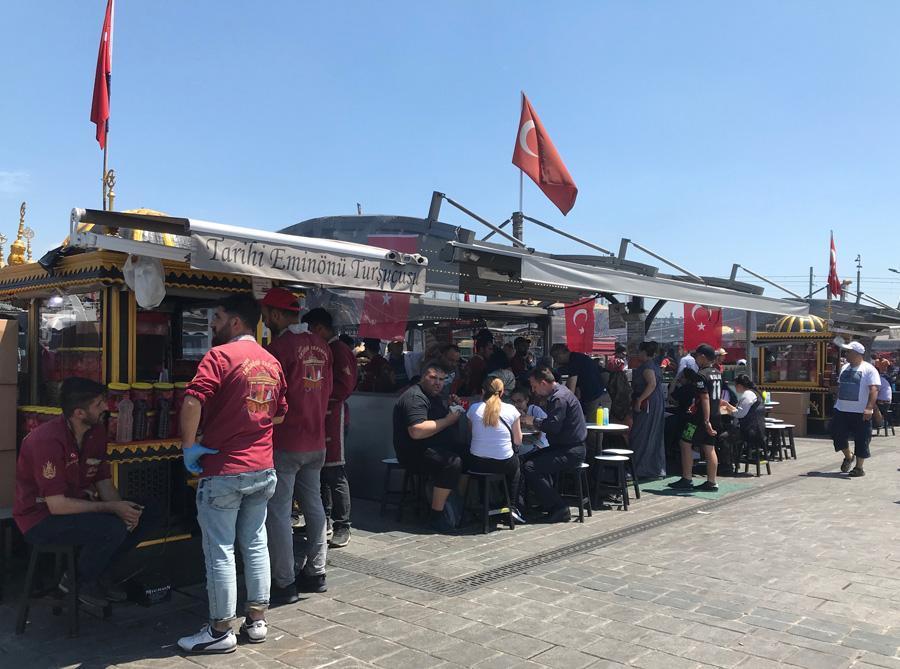Food and friendship - a Greek and Turkish bond
JANE SOFOS – ISTANBUL

Going to Istanbul with your Greek head on, you quickly become aware that you are in a city of unknown knowns. Creeping up on you when you are least expecting it, you suddenly realize that, either by the look of something or its name, you know exactly what you are dealing with. From the name for beans, “fasulye,” fassolia in Greek, to the word for a street, “sokağı” in Turkish and “sokakı” in Greek, the knowns are everywhere. Though the two languages seem almost totally impenetrable to each other, more frequently than you’d expect a familiar word pops up and you know exactly what’s going on.
I will not regurgitate the centuries of history that join Greece and Turkey; to be fair it is not the easiest of connections. Having said that, for two nations that can often be adversaries, these two countries and cultures could not be more closely related.
I need to lay out the basic reason for our Istanbul trip. It wasn’t simply for a cultural visit - it was born out of a 43- year-old friendship between my husband and his best friend. They were thrown together on a business studies course in Sheffield and were the only two foreign students, one Greek and one Turk. So, more than 40 years on we’re in Istanbul and with our friend as our host and our very special guide.
At his home we are, of course, the “misafir” - and our ears hear the familiar word “mousafiris” - guests. Dinner is dolma, stuffed vegetables and, less familiar, homemade manti - delicate Turkish ravioli - along with a good helping of seamless talk on the side. Above the chat and reminiscences, the call of the muezzin through the open windows reminds us that we are, after so many years, in Istanbul.
The days are filled with amazing sights: Topkapı, Hagia Sofia, and the Bosphorus and the one-step transition between the two continents of Europe and Asia. There are mosques, minarets, cisterns and churches, lives and intermingling cultures everywhere. And where there are people there is, inevitably, food.
When she was little, my sister wouldn’t eat anything unless she could have a look at it first - Greeks and Turks are the same. It was reassuring to see that in Turkey (it is less common in Greece these days) the mezze dishes are brought to the table on huge trays for the customers to choose once seen.
At Bebek Balıkçı, with a blissful view of gently lapping water and bobbing boats, it was a hard choice. Smokey aubergine purée, a sharp parsley salad, sea-fresh prawns and the most luscious cured bonito were finally decided on. And there was that hand of familiarity again: “maydanoz” like “maidanos,” the Greek word for parsley, “karides” the same as the Greek word for prawns; and we all knew what we were talking about when the bonito was identified as “lakerda.”
At the everyday restaurants in both Greece and Turkey all the food is on display - not just as images, but on trays of what you’re actually going to eat. And that is what is so important to the confidence of choice in a restaurant - we all know what we hope something will look, and obviously taste like what it appears on the menu, but the reality doesn’t always match the expectation.
Our lunch at Hünkar in the Nişantaşı neighbourhood immediately took me back to meals at Filippou in Kolonaki, Athens. These two restaurants are more closely related than cousins - I’d call them stepbrothers. From the crisp white tablecloths to the long-serving staff and including the more than dedicated clientele, these two establishments are definitely born from the same food culture. Both these places are not just restaurants, they are touch-points of familiarity for their customers - a culinary home from home. Obviously, the quality of the food and the service are exceptional, but mostly they just come to have good home-style food in a familiar environment.
People aren’t here to eat the latest food-fad - I can safely say that there’s not a glimpse of avocado or quinoa to be seen. Both Hünkar and Filippou are bastions of traditional cuisine, and apart from the occasional exception, most of the dishes are remarkably similar.
We could have eaten, “anginares”/”enginar” (artichokes) or maybe “börek”/ “bourekia” (pies), or “paça”/”patsa”, an intense broth made from veal trotters. I went for totally Turkish “hünkar beğendi” - the creamiest combination of pureed aubergine and bechamel with a braised lamb topping.
Eating our way through Istanbul, we had roasted chestnuts (“kastana”/”kestane”) on the street, drank the most surprising combination of fresh mulberry juice and vodka, and bought “fındıklar”/ “fountoukia” (hazlenuts) and “fıstık”/”fistikia” (peanuts) in the bazaar. We saw menus with “kokoreç”/”kokoretsi,” “pirzola”/”brizola” and “midye”/”midia.” We found a place more familiar than a foreign country and perhaps a little stranger because of that. Above all, we found that very old relationships are incredibly strong.
















